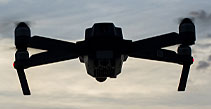Balloon, Kite and Drone Safety
Toys Can Cause Outages and Injuries
Believe it or not, kites, metallic balloons and drones can create serious electrical hazards. Here's what you need to know.
Metallic balloons, kites and drones may seem harmless, but flying toys may quickly go from fun to deadly if they become entangled in power lines.
 |
Metal is an especially effective conductor of electricity, and that includes the metallic coating on Mylar (or foil) balloons. When a Mylar balloon comes in contact with a power line, it can cause a short circuit. This can lead to power outages and fires. |
The short circuit can also create serious shock and electrocution hazards for any Utility Technicians working elsewhere on the power line.
Uh oh. Your kite, balloon or drone flew into some utility lines. Now what?
Do not try to dislodge any object that is stuck in a power line. Extending poles or sticks of any kind toward a power line can expose you and others to electrocution hazards.
If a kite, balloon or drone gets caught in a power line, call PSE&G immediately at 1-800-436-PSEG (7734).
How you can "fly" safely
- Always follow all applicable laws and regulations to include Federal Aviation Administration requirements.
- Never try to remove anything caught in power lines or in electric substations.
- Never fly kites or balloons in the rain or during electrical storms.
- Never cross a road or street while flying a kite or holding a balloon.
- Kites, Mylar balloons and drones should be kept away from overhead power lines and all utility equipment.
- Make sure balloons are secured to a weight that is heavy enough to prevent them from floating away.
- Always properly dispose of Mylar balloons safely by puncturing the balloon in several places to release the helium and prevent the balloon from flying away.
- Drones should be kept at least 200 feet from power lines, substations, etc., so you have time to maneuver the remote controlled aircraft away from electrical equipment.





















